
copyright 2009 by George Johnson
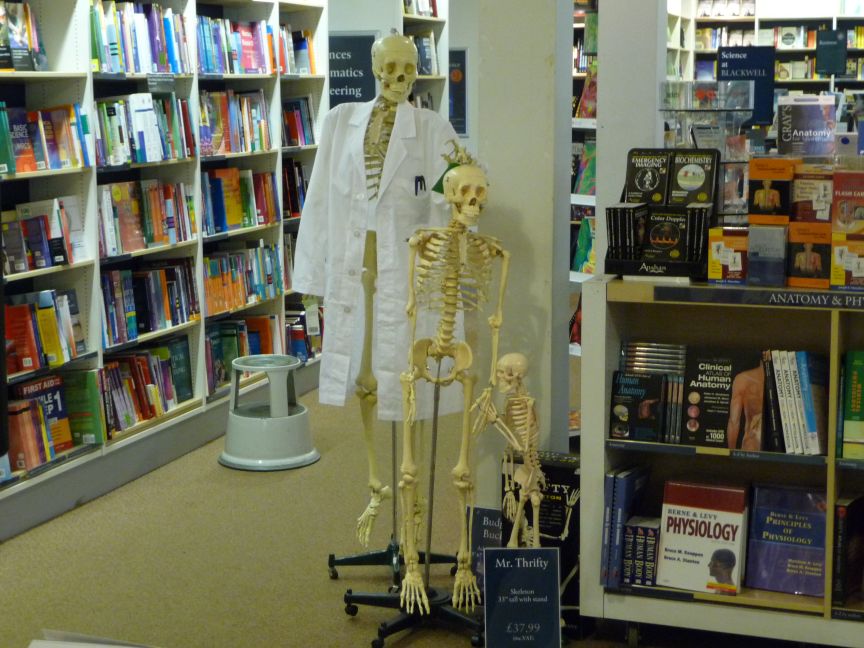
Waterstones Books, Edinburgh. photos by George Johnson, copyright 2009
1. Retrofit Arithmetic (and Rainbarrel Economics)
2. The San Juan-Chama Shell Game
3. The Case of the Disappearing Aquifer
4. The Creative Hydrology of Suerte del Sur
5. The City, the County, and a Water Tax Revolt
6. Water Numerology at City Hall
(Our story thus far)
7. The Woman at Otowi Gauge
8. "Forget it, Jake. It's Chinatown."
9. The Las Campanas Connection
(Our story continues)
10. The Engineering Solution
May 17, 2009
60. Down by the Riverside
Early this afternoon I parked at Frenchy's Field on Agua Fria Street and walked to the pedestrian bridge that spans the Santa Fe River. At the beginning of May, the city opened the gates at Nichols Dam and renewed its vow to restore water to the river. But some conservationists have worried that the small releases the city has agreed to would only be enough to sustain a flow through the Eastside and downtown. Politically that would be a setback for building citywide support for bringing the river to life again.
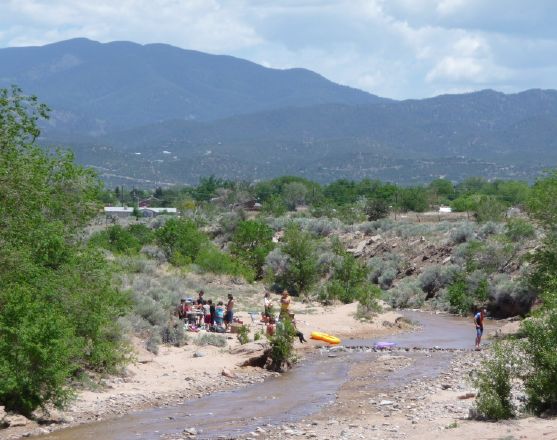
What a great surprise to see water coursing beneath Frenchy's bridge, and a family with inner-tubes playing on the beach. I continued farther south on Agua Fria and saw that the water had even reached the San Ysidro crossing . . . and the Caja del Oro bridge . . . and the Cottonwood Trailer Park -- and even an obscure crossing off Colony Drive (Paseo de River) on the other side of the Santa Fe bypass. With a slow, steady discharge of water -- an excess that in the past would have been flushed from the reservoirs in a single tsunami -- the Santa Fe River is flowing again all the way to the waste treatment plant on Airport Road, where it gets another jolt from the treated effluent emerging from the city sewer system.
Not all the news is good, however, for the lands along the riverside. Last week the City Council succumbed to the wishes of local developers and adopted a policy to urbanize rural areas of the county when they are annexed. Especially threatened is ranch land between the river and the bypass. Agua Fria Village could face the same fate as Corrales, a charming country enclave northwest of Albuquerque that has been surrounded by sprawl.
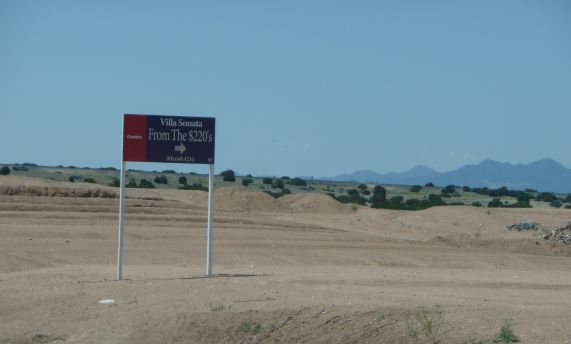
Santa Fe itself could soon be a defenseless island engulfed by neighborhoods manufactured by Centex, whose name (as Zane Fischer has noted, pitch perfect, in the Reporter) sounds like a deadly nerve gas. Last week as I headed for KSFR studios to record an interview for NPR's Morning Edition about the new movie Angels & Demons, (one of my more obscure subspecialties is writing about the human obsession with conspiracy theories) I saw a sign just off Richards Avenue announcing Villa Sonata, priced "from the $220s." It pointed toward acres of land scraped bare of weeds and criss-crossed by an empty grid of asphalt lanes leading to nothing but a graffiti-splattered construction trailer. Closer toward the Community College, Oshara Village (like Aldea de Santa Fe, a failed experiment in New Urbanism) was offering bargain prices.
Maybe the glut of half-finished subdivisions and other consequences of the recession will delay Agua Fria's demise. A recent walk down Marcy Street was a reminder that even downtown Santa Fe is showing the effects of a shrinking economy. Next to the offices of the Reporter is an empty storefront that once sold luxury furniture. The gallery space and law offices adjacent to the library parking lot are vacant now, and inside the library a sign at the circulation desk asks patrons to donate their unwanted pencils. Every penny counts. On the other side of the street, the old Thornburg offices at Marcy Plaza sit empty, and the two-story garage next door is offering public parking for the first time in ages. (Until Thornburg moved to the suburbs many of the spaces were probably leased for employees.)
On the west side of the garage, a half-completed second-story addition to the old Quintana Optical building has apparently been abandoned, and around the corner on Washington Street the old Territorial Inn, recently used as overflow office space by Sotheby's Realty, is empty now.
Sotheby's was the last of Santa Fe's agencies to keep running big ads in the Sunday New Mexican. Last week Sotheby's finally caved, cutting its presence in half. It was the most anemic real estate section yet -- only a page and a half of small display ads ("Amazing Homes in the Santa Fe Area") and a few columns of classifieds. The type on the open house listings had to be magnified to fill out the space. (Today's section looks only slightly healthier.)
Farther down Marcy across from City Hall, there is more vacant Thornburg space at First Interstate Plaza, or whatever it is called now. Between Lincoln and Sheridan Streets a large, outdated sign hangs on the renovated Esquina Building:
Coming in Fall 2008
Luxury
Residential, Office, Retail
What a limited market that must be. Who would pay a premium these days to live on a busy intersection across from the Santa Fe Convention Center -- or for that matter across from the county courthouse on Catron Street where Corazón de Santa Fe is still holding a perpetual open house, hawking its condos and time-shares? Every time I walk by I look to see if anybody is actually out barbecuing on their patio or sipping a margarita while watching jurors jockey for a vacant parking space.

May 18, 2009
Postscript
I've revised my earlier preamble to this post, which was based on an erroneous assumption. I learned this morning that the current flow in the river is not necessarily just two cubic feet per second. That is the minimum called for in the City Council's resolution. (Here is a copy.) Depending on conditions, the flow might be increased for short periods of time. I hope to hear more about this from the city.
May 19, 2009
Postscript
I've received an email from Claudia Borchert, the city water resources coordinator, who confirms that I was mistaken in thinking that a discharge of 2 cubic feet per second had revived the river as far as the treatment plant. In fact, she writes (rightfully miffed), 3 to 4 cubic feet per second was released from Nichols beginning May 1, and the flow was increased to 7 cubic feet on May 11.
That is still a fraction of the approximately 40 cubic feet per second (25 million gallons a day) that was flowing into the reservoirs from snow melt as recently as May 11, the last time the water division updated its statistics. But the question of how much river the minimum flow will sustain is still, alas, unresolved.
June 1, 2009
On Saturday there was still a healthy flow in the river as it passed Frenchy's Field, but by the time the water reached San Ysidro Crossing it was just a trickle. Claudia Borchert at the city tells me that between 4.9 and 5.8 cubic feet per second were being let go that day from Nichols Reservoir -- maybe a third less than earlier this month when the river had been recreated all the way to Airport Road. Later this week, she said, the city aims to reduce the flow to around 4 cubic feet in preparation for the annual weekend fishing derby. This has the makings of a good experiment. Barring some significant thunderstorms, which feed the river below the dam and throw off calculations, we'll be able to judge the effect of the cutback on the length of the river.
Rivers in the West have become artifices of engineering. In Encounters with the Archdruid, John McPhee chronicles a raft trip through the Grand Canyon with David Brower, the first executive director of the Sierra Club and founder of Friends of the Earth (he's the archdruid), and Floyd Dominy, the Bureau of Reclamation commissioner who never saw a river he didn't want to dam. After shooting some rapids (and a few cans of Budweiser) with his protagonists, McPhee recollects a tour they all had taken a few miles upstream at Glen Canyon Dam.
"What seemed unimaginable beside the river in the canyon," McPhee wrote, "was that all that wild water had been processed, like pork slurry in a hot-dog plant." He goes on to describe a chamber down inside the concrete monolith where operators portion out the river on demand:
They wear slim ties and white short-sleeved shirts. They make notes on clipboards. They sit at desks, and all around them, emplaced in the walls of the room, are gauges and dials, and more gauges and dials . . .
One thing I like so much about this book is how it captures the ambiguity I feel when I visit one of the huge Bureau of Reclamation sites: awe at the might of the technology and the grace of the architecture, and sadness at what has been lost.
In an essay in Desert Solitaire, Edward Abbey described his own trip on the Colorado, through the magnificence of Glen Canyon before it was plugged, its depths and complexity flattened into a surface for motorboats. Later in The Monkeywrench Gang, he fantasized about blowing up the dam. But not even Abbey was that crazy.
Wildness doesn't trump everything. At the Grand Canyon (the only literally breathtaking place I've seen), I've admired the Mary Colter architecture and enjoyed a good dinner at El Tovar. In Santa Fe I'd love to see the river trail extended, with bridges and rock work, past Patrick Smith Park, all the way east through the backyards of upper Canyon Road.
There is a balance to be struck between taming a river and suffocating it. Santa Fe, until just recently, has leaned in the deadlier direction.
June 8, 2009
Mansion Watch
In a front-page story yesterday on possible changes to Santa Fe's toothless ridgetop ordinance, the New Mexican reports that Andrew and Sydney Davis, who despoiled Santa Fe's northeastern horizon with their hilltop mansion, "could not be reached for comment." They needn't have worried about talking to the press. Here is the paper's sympathetic account of the case:
About five years ago, Andrew and Sydney Davis went through a painful process when they proposed to build a home east of Hyde Park Road at the end of Monte Verde Street, a hilltop with up-close views of the Sangre de Cristos and a wide-angle lens on the city spread below.
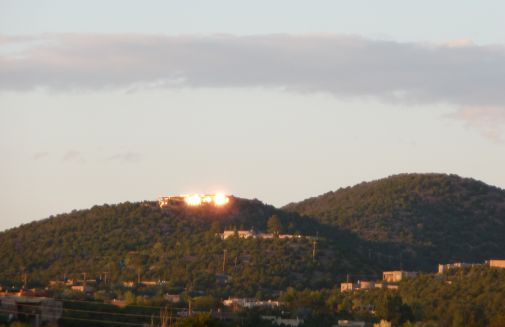
As if the Davises were the recipients and not the inflicters of the pain. (For the record, their street is west, not east, of Hyde Park Road.)
The solicitude conveyed by the reporter's otherwise objective account is sadly familiar. As noted here before the Davises' philanthropy has paid off. Give enough money to the right causes and you can transform the city's skyline for your own aggrandizement.
The New Mexican story also mentions the Tom Ford mansion, which in my mind occupies a lesser circle of hell than the Davis's. For all its extravagance, Mr. Ford's castle is not nearly so visible, and it was approved after public hearings and meetings with neighbors. It was also constructed without reshaping a hilltop visible throughout town.
Mr. Ford's builder, Doug McDowell, is moving forward with his own endeavor: a subdivision called Mirasol on the lower slope of Sun Mountain. Since I last wrote about the project, the number of houses has been reduced from 16 to 13. That is not as good as it sounds. Under Santa Fe's land use code, each of the homeowners would have the right to build a guest house and rent it out.
Visually Mirasol's impact would not be nearly as great as that of the hilltop mansions. None of the houses would be anywhere close to the top of the mountain. In a recent email Mr. McDowell told me that he is having discussions with the project's neighbors, who have banded into a group called (a bit histrionically) Save Sun Mountain, and will consider their offer to buy the land and preserve it as open space.
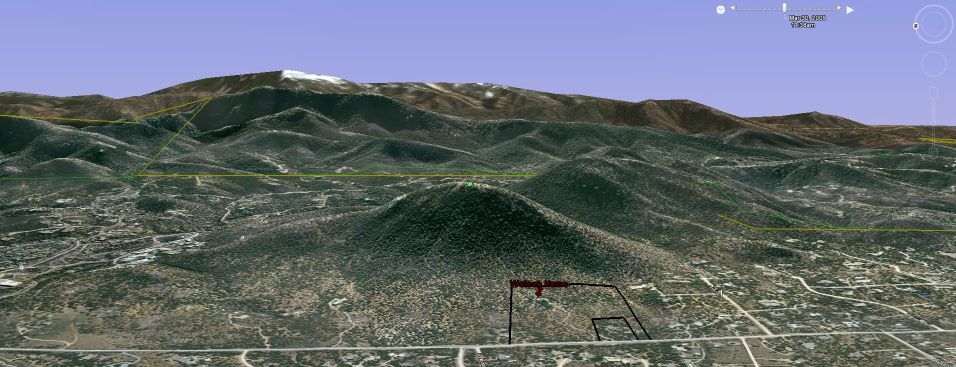
June 11, 2009
Zooming-in on the rental racket
If you click on the image above you will be taken to an interactive map showing the 350-plus vacation rentals (here is the list) registered with City Hall since tourist lodging was legalized last year in residential neighborhoods. The markers are color-coded to indicate the real estate company that advertises and manages the rental for a cut of the proceeds: Red = The Management Group, Yellow = Kokopelli, Green = Casas de Santa Fe, Purple = Colorfulsantafe, Turquoise = Santa Fe Stay. Blue pins are for individual owners or smaller management firms.
It's a depressing sight. Entire blocks of housing stock have been turned into business strips. Take a look at historic Garcia Street south of Acequia Madre:
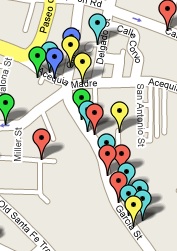
Or the blocks around Montoya Circle near Cerro Gordo and East Alameda:
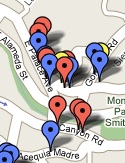
Anyone who bought a home on these streets with the thought of actually living there has been damaged by what amounts to a rezoning. Now their only recourse is to join together and sue.
Even sadder is what has happened to modest streets like Otero between Sunset and Artist Road and other blocks just east of Fort Marcy Park:

When I moved to Santa Fe in 1992 this was a neighborhood with relatively reasonable rents, where artists, writers, and young post-docs at the Santa Fe Institute could find digs. The same was true of the old neighborhoods along West San Franscico and Alto:
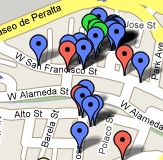
All these opportunities to live downtown have been wiped out by legalizing short-term rentals. The incursions came gradually and surreptitiously. By giving in instead of fighting back, the city has dealt a blow to affordable housing more serious than the one caused by the defeat last spring of the real estate transfer tax.
The ordinance will come before the Council for review later this summer. That would be an ideal time to overturn it and implement a plan to phase out all short-term rentals in residential neighborhoods over the next few years. Judging from this morning's New Mexican, the opposite will probably happen, with Councilor Wurzburger, who led the drive for legalization, pushing to make it even easier for these operators to open shop.

June 12, 2009
Postscript
I've updated the list and the map with a couple of dozen additional rentals.

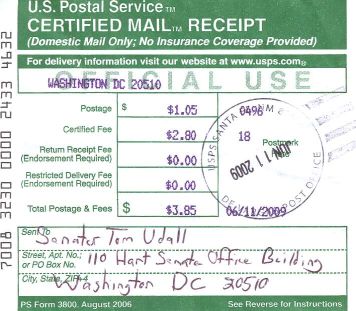
Whenever I pass by the Indian School campus on Cerrillos Road and see the results of the senseless clear cutting of all those old trees, the stumps still sticking from the ground, I feel as baffled as I feel sad. What could this be but another gesture of contempt by the people who bulldozed the historic buildings with no regard for federal preservation law?
It has been three months since I heard from Scott Culver, assistant inspector general at the Department of the Interior in Washington, acknowledging receipt of my letter about probable violations of the National Historic Preservation Act. I say "probable" and yet everyone I talk to who is conversant in preservation law is certain that either the Bureau of Indian Affairs or the All Indian Pueblo Council seriously breached Section 106 of NHPA. They also share the expectation that Interior, through a misplaced sense of political correctness, will sweep the matter under the rug.
Yesterday I wrote again to Senator Udall, asking him to intervene. (Those new to the story can find a detailed report here.)
On another matter, I just heard from Doug McDowell, who tells me that his development will include covenants prohibiting freestanding guest houses. They would have to be "architectually attached and integrated" into the main design. I also heard from Karen Peterson at the Journal, pointing me to an editorial she wrote on Sunday. I don't know how I missed it.
June 17, 2009
With the annual fishing derby out of the way, the city has throttled back the river to the minimum called for in the City Council resolution: 2 cubic feet per second (this from Claudia Borchert at the Water Division). Yesterday afternoon there was still a small but vigorous flow running beneath the Guadalupe Street bridge and reaching all the way to St. Francis Drive. But by the time the water approached Camino Alire it was barely a trickle, and the Camino Carlos Real crossing was bone dry.
According to the most recent weekly water report (June 14), 8.4 cubic feet per second (5.43 million gallons a day) has been flowing into the dams from the watershed. But almost 11 cubic feet per second was being sucked up by the Canyon Road treatment plant to feed the city waterworks. Only three of the 13 Buckman wells were running and two of the seven city wells. The river was providing nearly two-thirds of Santa Fe's drinking water.
Once the Buckman Direct Diversion is operating, there should be enough slack to increase the minimal river flow. As we've noted here before, the County has rights to more Buckman water than it currently has the infrastructure to use. The Journal reported earlier this month that the County has agreed to give some of the excess -- 1,000 acre-feet a year -- to the city, allowing it to draw that much less from the Santa Fe River. The difference could be enough to have a river running from spring to fall way past the County line.
Ms. Borchert told me, however, that this is not a done deal. For one thing the Buckman water will be high maintenance -- it must be cleaned of sand and mud before it is pumped 15 miles and 1,700 feet uphill. The extra work will cost the City more per gallon than clean, gravity-propelled Santa Fe river water. The City Council will have to be persuaded that the money is worth it.
The investment would pay dividends. A significant amount of what is released from the dams into the river trickles down through the sands and replenishes the aquifer. An important new paper by hydrologists Paige Grant and Neil Williams reminds us of the benefits: "Water that is 'used' for flow in the river, and then infiltrates into the aquifer can be recaptured and reused through existing City and private wells." The water is not lost. It is stored for the future.
June 22, 2009
I sent an email this morning to Laura Banish, Santa Fe's first-rate public information officer. A robot replied:
The City of Santa Fe Public Information Office has started the transition from a two-person to a one-person staff . . .
Laura and her job will soon be gone. Actually I'd already heard that she was leaving. I was glad to receive, several minutes later, an email confirming that she will be moving to New York to study political science at the New School. "I'm very interested in civic engagement and policy development," she told me.
Through my work at the city, I have seen that the best policy arises out of transparent public discourse, and access to government improves the quality and legitimacy of the decision-making process -- however this doesn't happen nearly on the scale that it ought to.
Graduate school is a wonderful opportunity for her, and she will bring to the classroom invaluable real-life experience. Laura has seen the arcane workings of a small city government from both the outside, as a reporter for Journal North, and deep inside City Hall, where she has fought an uphill battle against bureaucrats and politicians who treat public information as their private property.
How predictable that instead of finding someone to fill her shoes, the City is eliminating the position. After graduation I hope she will consider a career in screenwriting. Imagine something like "The Wire" set in Santa Fe and the cast of characters it would involve.

Coming soon: The College of Santa Fe
A Special Report: The Mysterious Destruction of the Santa Fe Indian School
The Andrew and Sydney Davis Webcam
A Stroll Along Shirley Maclaine Boulevard
The Santa Fe Review

More links:
See the current flow of the Santa Fe River above McClure Reservoir with the USGS automated gauge.
The Otowi gauge shows the flow of the Rio Grande north of Santa Fe.
Santa Fe water information, a collection of documents and links
|
|
|
|
|
|
|
|